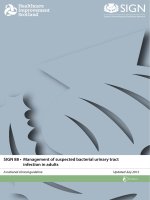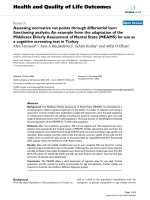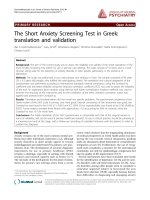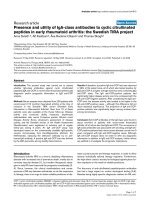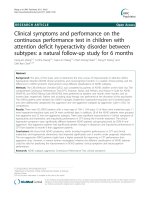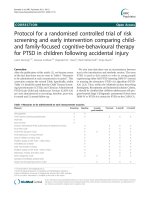Utility of screening test in early diagnosis of urinary tract infection in children
Bạn đang xem bản rút gọn của tài liệu. Xem và tải ngay bản đầy đủ của tài liệu tại đây (179.22 KB, 7 trang )
Int.J.Curr.Microbiol.App.Sci (2019) 8(1): 1700-1706
International Journal of Current Microbiology and Applied Sciences
ISSN: 2319-7706 Volume 8 Number 01 (2019)
Journal homepage:
Original Research Article
/>
Utility of Screening Test in Early Diagnosis of
Urinary Tract Infection in Children
Smita Bawankar, Aakanksha Sharma*, Khyati Jain, Surendra Chauhan and Mustafa
Department of Microbiology, Shri Shankaracharya Institute of Medical Sciences, Bhilai, India
*Corresponding author:
ABSTRACT
Keywords
Urinary tract
infection,
Asymptomatic
bacteriuria,
Semiquantative
culture, Screening
tests
Article Info
Accepted:
12 December 2018
Available Online:
10 January 2019
Urinary tract infection (UTI) is a common disease affecting especially infants and young
children. The clinical presentations are diverse, from an unaffected infant with
asymptomatic bacteriuria to a severely septic child. Accurate and timely diagnosis and
treatment is important for the prevention of long-term morbidity and sequelae (e.g.
hypertension, proteinuria, and chronic kidney disease). The purpose of the present study
was to determine the validity of rapidly diagnostic tests for the early detection of UTIs in
paediatric patients. Total 247 midstream urine specimens were processed. On one part of
sample semiquantitative culture was done and on another part various screening test (wet
mount, Gram’s stain, catalase test, triphenyl tetrazolium chloride test and modified Griess
nitrate test) were performed and compared with culture. Out of 247 urine samples,
58(23.48%) samples were culture positive. E. coli was most common bacteria pathogen
isolated. Among screening tests, modified Griess nitrate test and TTC test were more
specific. While catalase test and Gram stain were both sensitive and specific. Wet mount
examination found to be the least useful test. Combination of screening test can be helpful
especially in setup where laboratory facility for culture is not available for diagnosis of
urinary tract infection.
Introduction
Urinary tract infection (UTI) is recognized
increasingly as a common cause of fever in
young children. Urinary tract infection (UTI)
is a common serious bacterial infection in
childhood. However, clinical findings
indicative of UTI in this group are often subtle
and nonspecific, with fever often the only
finding (Gorelick et al., 1999). The
importance of UTIs is reflected not only by
their frequency but also by the range of
clinical severity that may occur, from
asymptomatic to
mild
or moderate
symptomatic lower UTI to bacteremia and
septic shock. In addition, it has been shown
that UTIs with fever in young children
increase the probability of kidney involvement
and are associated with an increased risk of
underlying nephrourologic abnormalities and
consequent renal scarring (Christopher et al.,
2016). It affects male children more than
female in first year of life and female after 1
year of age. There are several risk factors for
pediatric urinary tract infections. Neonates and
infants in their first few months of life are at
1700
Int.J.Curr.Microbiol.App.Sci (2019) 8(1): 1700-1706
higher risk for UTI. This susceptibility has
been attributed to an incompletely developed
immune system. Clinical presentation of UTI
in infants and young children can be very
subtle and atypical and a high index of
suspension must be kept in order to diagnose
(Gorelick et al., 1999). UTI in Children should
be suspected if there is presence of fever,
chills and rigor, burning micturation, foul
smelling of urine, pain abdomen, vomiting,
facial puffiness, loose stool, seizures,
hematuria, constipation, loss of appetite and
failure to thrive (Shrestha et al., 2013; Elder et
al., 2007).
culture as the gold standard (Mundhada et al.,
2016).
Materials and Methods
The present study was carried out in the
Department
of
Microbiology,
shri
shankaracharya institute of medical sciences,
Chhattisgarh during Jan 2018 to Nov 2018.
Children ranging from 2 months up to fifteen
years of age of either sex seen in the OPD or
Wards with a clinical diagnosis of UTI were
taken as the study subjects.
Processing of specimen
The management and diagnosis of UTI in
children are different from adults and require
special consideration.
Many prompt diagnostic methods are
available including screening tests like wet
mount microscopy, Gram stain, catalase test,
Nitrate test, Triphenyl tetrazolium chloride
test, but gold standard method for diagnosis of
UTI is quantitative urine culture. Urine culture
is an expensive, time consuming procedure
and needs a well-equipped microbiology
laboratory with experienced technicians.
While On the other side, Screening tests of
urine sample are designed to allow early
detection of infection in the emergency
department and an earlier initiation of the
treatment. They are inexpensive, less timeconsuming, easy to perform, no expertise
required to perform and are useful in small
laboratories having no culture facility.
Due to clinical significance of early diagnosis
of UTI, different screening tests are used
widely, but their performance characteristics
are still questionable. The aims of the present
study were: to study the prevalence of
bacterial pathogens causing urinary tract
infection among children; to evaluate the
accuracy of different screening test for
diagnosis of UTI, keeping semi quantitative
The midstream, clean catch specimens of
urine were collected in sterile universal
container from paediatric patients with clinical
diagnosis of UTI.
In children under 2 years of age urine was
collected in a sterile bag and in above 2 years
freshly passed clean‑ catch mid‑ stream urine
was collected aseptically (Pal N et al., 2016).
Urine specimens were screened for significant
bacteriuria by following screening tests
(Collee et al., 2006; Palmer, 1997; Hinton and
Hoeve, 1965; Srihari et al., 2012):
Wet Film Examination
Triphenyl Tetrazolium chloride reduction test
(TTC test)
Gram Staining. The following screening tests
were done.
Catalase test
Modified Griess Nitrite Test
Wet film examination: Pus cells/high power
field (hpf) were counted. About 20 fields were
searched. Finding >1 pus cell/ 7 hpf indicates
significant pyuria. Apart from pus cells, RBC,
any casts, bacteria, yeast cells were also noted.
Gram Staining: The presence of ≥1
bacteria/Oil immersion field in 20 fields
1701
Int.J.Curr.Microbiol.App.Sci (2019) 8(1): 1700-1706
correlated with the diagnosis of significant
bacteriuria of ≥105 CFU/ml of urine.
Catalase test: Four drops of 10% hydrogen
peroxide were added in 2 ml of urine in the
test tube. The mixture was shaken gently for 5
seconds. Formation of effervescence to form a
complete ring or layer on the surface of the
liquid within 1 to 2 minutes was taken as
positive test. Positive control- Staphylococcus
aureus and Negative control - Enterococci
species.
Triphenyl tetrazolium chloride (TTC) test:
2 ml of urine was taken in a sterile test tube
and 0.5 ml of working triphenyl tetrazolium
chloride reagent was added. This mixture was
incubated at 370C for 4 hours. Formation of
red precipitate indicated a positive test.
Modified Griess nitrite test: 8 ml. of urine
was taken in a test tube and centrifuged this
for 15 minutes. The supernatant was decanted.
To the precipitate, 0.5 ml. of a 10%solution of
potassium nitrate was added. This was
incubated for one and half hour at room
temperature.
Then, 1 ml of the Griess reagent (0.5ml of
solution A: Sulphanilic acid + 0.5ml of
solution B:α-naphthylamine) was added to it.
The development of a pink or a red colour in a
matter of seconds was considered to be a
positive test. Asepsis was strictly observed.
Positive control –E. coli and Negative control
– Enterococci species.
Culture
Urine specimens from 247 clinically
diagnosed UTI patients were subjected to
culture for identification of different microorganisms.
1μl) was used to inoculate urine sample to the
culture media (Blood agar and MacConkey
agar).
Identification of bacteria
All bacteria are identified by routine standard
technique (Collee et al., 2006).
Statistical analysis
Sensitivity, specificity, positive and negative
predictive value were calculated according to
the following formulae
Sensitivity = True positive/(True positive +
False negative), the probability that the
screening test will be positive in patients with
urinary infection (positive culture).
Specificity = True negative/(True negative +
false positive) the probability that the
screening test will be negative in patients
without urinary infection (negative culture).
Positive predictive value = True positive/(True
positive + false positive), the probability that
urinary infection is present when the screening
test is positive.
Negative
predictive
value
=
True
negative/(True negative + False negative), the
probability that a urinary tract infection is not
present when the screening test is negative.
True positive stands for (Screening test and
culture both positive), False positive stands for
(Positive screening test and negative culture),
True negative stands for (Screening test and
culture both negative) and False negative
stands for (Screening test negative and culture
positive).
Antimicrobial susceptibility test
Quantitative culture
Calibrated bacteriological loop (calibrated to
Antimicrobial
susceptibility
test
was
performed by using Kirby Bauer disc diffusion
1702
Int.J.Curr.Microbiol.App.Sci (2019) 8(1): 1700-1706
method by following the Clinical Laboratory
Standards Institute (CLSI) guidelines.
Results and Discussion
Out of 247 samples taken from paediatric
group 58 (23.48%) showed significant
bacteriuria by the semiquantitative culture
method which is similar to that reported by
(Pal et al., 2016). in our study there is female
predominance (67.24%) except during first
year of life. where male is most affected
which is correlated with the finding of
Gorelick et al., (1999). The reason of this
disease being more common in female child is
probably short urethra in females besides
others factors (Shrestha et al., 2013). Most
common organisms isolated was – E. coli
(65.51%) followed by Proteus species
(13.79%), Klebsiella species (10.34%),
Pseudomonas aeruginosa (3.44 %) and
Staphylococcus aureus (4.34%), one isolate
each of Enterococci species (1.72%) and
Staph saprophyticus species (Table 1 and 2).
Table.1 Age and sex distribution of culture positive urinary isolates among paediatric population
2m-1yr
4(21.05%)
5(12.82%)
Male
Female
1-5yr
8(42.10%)
18(46.15%)
5-10yr
4(21.05%)
9(23.07%)
10-15yr
3(15.78%)
8(20.51%)
Total(58)
19(32.75%)
39(67.24%)
Table.2 Frequency of organisms isolated from urine sample on culture (N=58)
Organism isolated
E.coli
Klebsiella species
Proteus species
Pseudomonas aeruginosa
Staphylococcus aureus
Staphylococcus saprophyticus
Enterococci species
Number (%)
38 (65.51)
6 (10.34)
8 (13.79)
2 (3.44)
2 (3.44)
1 (1.72)
1 (1.72)
Table.3 Sensitivity, specificity and predictive value of various screening tests
Tests
Sensitivity (%)
Specificity (%)
Wet mount
Gram stain
Catalase test
TTC test
Modified
Griess Nitrite
test
63.04
78.26
94.93
86.23
86.95
86.42
88.89
90.74
95.67
94.44
For all the organisms isolated (Gram positive
and Gram negative), imipenem was the most
Positive
predictive
value (%)
69.60
85.71
89.73
94.44
93.02
Negative
predictive
value (%)
70.85
82.76
95.45
89.08
89.47
sensitive drug 55 (94.82%), followed by
nitrofurantoin 52 (89.65%), amikacin
1703
Int.J.Curr.Microbiol.App.Sci (2019) 8(1): 1700-1706
48(82.75%), gentamicin 45(77.58%) and
ciprofloxacin 42(72.41%). Evaluation of
various screening tests in relation to the
culture is as given below (Table 3). The
diagnosis of UTI is currently based on
concept of quantitative bacteriuria, but for
mass detection of UTI especially in risk
groups like diabetics, antenatal cases and
children in health surveys, reliable screening
method is essential. The purpose of urine
screening is to eliminate those specimens that
do not contain significant number of bacteria.
In present study, sensitivity and specificity of
wet mount (pyuria) was 63.33% and 57.14%
respectively. Similar results were noted by
soma et al., (2018). There were 12 samples in
which pus cell were found in urine but there
was no significant growth on culture media
indicating
either
sterile
pyuria
or
disintegration of the pus cells due to the
presence of Proteus, Klebsiella and
Pseudomonas in alkaline urine. Also the
positive predictive value was less i.e. 61.29%
making this test less useful in the diagnosis of
urinary tract infection. The urine Gram stain,
has been proposed both as a more sensitive
and specific method for identifying patients
with UTI, especially as a screening test when
compared with culture (Mustafa et al., 2008).
But in our study, sensitivity was 84.61%
which is similar to the finding of (Mustafa et
al., 2008) and specificity of Gram stain 85.71
% which was comparable to results noted by
(Anchinmane et al., 2018).
In this study, Catalase test was found to be
93.75% sensitive and 69.23% specific
whereas 88.63% and 75.86% sensitivity and
specificity respectively were noted by Ninama
(2016). There were 8 samples which were
catalase positive but did not show any growth
on culture media which might be due to
haematuria in the patients. By Triphenyl
Tetrazolium chloride(TTC) test we obtained
88.88 sensitivity but lower specificity
63.66%.Other worker like Agrawal et al.,
(1986) and Wagle et al.,(1989) noted similar
finding.
Specificity (95.65%) of Modified Griess
nitrate test was more than Sensitivity
(91.66%) in present study.so test is more
useful in rolling out UTI in patients also the
positive predictive value is 97.05% Similar
finding were noted by Mustafa et al., (2008).
while in contrast result was noted by Taneja
et al., (2010) Total 3 false negative samples
were noted as nitrate test does not detect
organisms unable to reduce nitrate to nitrite,
such as Enterococci, Staphylococci species,
Acinetobacter etc.
Rapid diagnostic tests can rule out negative
samples, are economical, save valuable time
and thus useful in high-end laboratories.
Screening is also required in special
circumstances where it is difficult to identify
UTI on basis of clinical criteria alone but
where early diagnosis and prevention of
complications affords significant benefit (e.g.
children, and post renal transplant patients)
(Deville et al., 2004). But due to different
sample population in different studies like
high risk population, Gender, Children or
because of variation in procedure while
performing tests, it results in variation in
performance of different screening tests.
Therefore a combination of screening tests
should be used for diagnosis of UTI as there
is no single test with 100% sensitivity and
specificity.
In conclusion, urine culture remains gold
standard method for diagnosis and
confirmation of UTI in the laboratories were
adequate culture facilities are available.
Timely diagnosis and prompt treatment of a
febrile UTI is important to eradicate the acute
infection, to prevent bacteremia (in particular,
young infants less than 3 months of age), to
improve the clinical condition, and possibly to
reduce the likelihood of renal damage. But in
1704
Int.J.Curr.Microbiol.App.Sci (2019) 8(1): 1700-1706
resource limited area where culture facilities
are not available or labs with high patient load
combination of screening test will be helpful
to reduce morbidity associated with urinary
tract infection.
References
Anchinmane VT, Preet K, Sankhe S. Utility
of urinary gram stain as a diagnostic
method for urinary tract infection. Int J
Res Med Sci 2018;6:610-2.
Agrawal SK, Das R, Goel M, Kumar M.
Tetrazolium reduction test in diagnosis
of urinary tract infections. Indian I
PatholMicrobiol 1986; 29: 61-65.
Christopher D, Doern, A. Susan, E.
Richardsonb. Diagnosis of Urinary
Tract Infections in Children. Sep 2016
Vol 54 No. 9 Journal of Clinical
Microbiology.
Collee JG, Miles RS, Watt B. Laboratory
strategy in the diagnosis of infective
syndrome. In: Colle JG, Fraser AG,
Marimon BP, Simmons A, editors.
Mackie and McCartney Practical
Medical Microbiology. 14th ed.
Edinburg:
Elsevier
Churchill
Livingstone; 2006. p.84-90.
Deville WLJM, Yzermans JC, van Duijin NP,
Bezemer D, van der Windt DAWM,
Bouter LM. The urine dip stick test
useful to rule out infections. A
metaanalysis of the accuracy. BMC
Urology 2004; 4: 4-17.
Elder JS, Urinary tract infections. Kliegman
RM, Behrman RE, Jenson HB, Stanton
BE, editors. Nelson Text book of
Pediatrics. Philadelphia: 2007. Pp.
2223-8.
Gorelick MH, Shaw KN. Screening Test for
Urinary Tract Infection in Children: A
meta analysis. Pediatrics 1999; 104:54.
Hinton NA, Hoeve E. The Detection of
Significant Bacteriuria: An Assessment
of the Triphenyl tetrazolium Chloride
Reduction Test. Canad. Med. Ass. J.
1965; Vol. 93: 639-42.
Mustafa Yildirim, İdris SAHİN, Abdülkadir
Küçükbayrak, Şükrü Öksüz,Selda Acar,
M. Tevfik Yavuz Düzce Tıp Fakültesi
Dergisi the validity of the rapidly
diagnostic tests for early detection of
urinary tract infection. 2008; 3:39-42.
Mundhada SG, Ingole KV, Bhise MP, and
Shaikh SV. Evaluation of different
screening tests for detection of Urinary
Tract Infections in pregnant women
attending
the
antenatal
clinic
Int.J.Curr.Microbiol.App.Sci
(2016)
5(4): 772-777.
Ninama AB, Shah PD. Comparison of various
screening methods for presumptive
diagnosis of significant bacteriuria. Int J
Med Sci Public Health 2016; 5: 10661069.
Pal N, Rit K, Naskar S, Kumar S,
Guhathakurata R. A study of
bacteriological
and
antibiotic
susceptibility profile of pediatric urinary
tract infection with special emphasis on
extended spectrum beta‑ lactamase
production in a tertiary care hospital of
Eastern India Int J Health Allied Sci
2016; 5: 257-62.
Palmer LS, Richards I, Kaplan W. Clinical
evaluation of a rapid diagnostic screen
(Uriscreen) for bacteriuria in children. J
Urol 1997; 157: 654-657.
Shrestha SP, Shrestha AK, Lamsal L and
Joshi M. Bacteriological profile of
urinary tract infection in children at
GMC teaching hospital. Journal of
Chitwan Medical College, 2013; 3(5):
22-25.
Soma Mondal, Avijit Mondal, Kuhu Pal,
Indira Paul Utility of simple urinary
screening tests to rule out UTI in
Pediatric population IOSR-JDMS 2018;
vol 17(2): 24-28.
Srihari A, Beeregowda YC, Vishnu Vardhan
Reddy T. A comparative study of Griess
1705
Int.J.Curr.Microbiol.App.Sci (2019) 8(1): 1700-1706
nitrate test and urinary culture in
detection of asymtomatic bacteriuria in
children. Int J Biol Med Res. 2012;
3(1): 1439-41.
Performance Standards for Antimicrobial
Susceptibility Testing; Twenty-fifth
Informational
Supplement.
CLSI
document M100-S25. Wayne, PA:
Clinical and Laboratory Standards
Institute; 2015.
Taneja N, SS Chatterjee, M Singh, S
Sivapriya, M Sharma, SK Sharma.
Validity of Quantitative Unspun Urine
Microscopy, Dipstick Test Leucocyte
Esterase and Nitrite Tests in Rapidly
Diagnosing Urinary Tract Infections.
JAPI Aug 2010. VOL. 58:485-8
Wagle N, Vaidya A, Joshi S, Merchant S.
Triphenyl Tetrazolium Chloride (TTC)
dye test for quick diagnosis of urinary
tract infection. Indian Journal of
Pediatrics, 1989 sept; Vol. 56(5): 63538.
How to cite this article:
Smita Bawankar, Aakanksha Sharma, Khyati Jain, Surendra Chauhan and Mustafa. 2019.
Utility of Screening Test in Early Diagnosis of Urinary Tract Infection in Children.
Int.J.Curr.Microbiol.App.Sci. 8(01): 1700-1706. doi: />
1706
